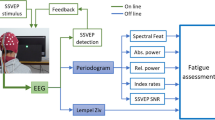Abstract
Purpose
The relationship between eye movements and the visual evoked potential (VEP) response was examined in two subjects with infantile nystagmus syndrome (INS). Changes in VEP amplitude were compared between periods of foveation versus periods of high-frequency nystagmus. An analysis is proposed that improves extraction of the checkerboard reversal VEP signal from subjects with INS.
Methods
INS subjects were 2 healthy children (12–13 years old) with 20/40 or better corrected acuity. Optical coherence tomography confirmed the optic nerves, retina, and fovea were within normal variation. VEPs were recorded to checkerboard reversal and to onset/offset of horizontal gratings while simultaneously recording the electrooculogram (EOG). VEP epochs underwent Fourier analysis, and epochs were examined for phase consistency with the mean. Foveation periods were compared to video-oculography recordings from a separate session.
Results
Optic nerve misrouting, such as crossed VEP asymmetry seen in albinism, or ipsilateral VEP asymmetry seen in achiasma, was not detected in either subject. By averaging only epochs in which EOG epochs showed foveation, VEP amplitude could be increased ≥59%. Averaging the VEP only on epochs with consistent phase at Oz increased VEP amplitude by ≥twofold; subsequent EOG epochs after this analysis mostly contained foveation periods or minimal EOG activity. Latency varied <14 ms across all analyses.
Conclusions
The checkerboard reversal VEP signal is dependent on foveation periods in subjects with INS despite good visual acuity. Reduction in VEP amplitude due to retinal image motion induces noise and/or lack of phase locking in the VEP epochs. Selective averaging of epochs based on phase consistency improves the extraction of a VEP signal, likely when retinal image motion is minimized.






Similar content being viewed by others
References
Dell’Osso LF, Daroff RB (2007) Nystagmus and saccadic intrusions and oscillations. In: Tasman W, Jaeger EA (eds) Duane’s ophthalmology, Electronic edn. Lippincott Williams & Wilkins, Philadelphia
Leigh RJ, Zee DS (1991) The neurology of eye movements, 2nd edn. FA Davis, Philadelphia
Abadi RV, Bjerre A (2002) Motor and sensory characteristics of infantile nystagmus. Br J Ophthalmol 86:1152–1160
Dell’Osso LF, Daroff RB (1975) Congenital nystagmus waveforms and foveation strategy. Doc Ophthalmol 39:155–182
Dell’Osso LF, Van der Steen J, Steinman RM, Collewijn H (1992) Foveation dynamics in congenital nystagmus I: Fixation. Doc Ophthalmol 79:1–23
Westheimer G, McKee SP (1975) Visual acuity in the presence of retinal image motion. J Opt Soc Am 65:847–850
Kelly DH (1979) Motion and vision. II. Stabilized spatiotemporal threshold surface. J Opt Soc Am 69:1340–1349
Demer JL, Amjadi F (1993) Dynamic visual acuity of normal subjects during vertical optotype and head motion. Investig Ophthalmol Vis Sci 34:1894–1906
Abadi RV, Worfolk R (1989) Retinal slip velocities in congenital nystagmus. Vis Res 29:195–205
Bedell HE, Loshin DS (1991) Interrelations between measures of visual acuity and parameters of eye movement in congenital nystagmus. Investig Ophthalmol Vis Sci 32:416–421
Cesarelli M, Bifulco P, Loffredo L, Bracale M (2000) Relationship between visual acuity and eye position variability during foveations in congenital nystagmus. Doc Ophthalmol 101:59–72
Weiss AH, Kelly JP, Phillips JO (2011) Relationship of slow-phase velocity to visual acuity in infantile nystagmus associated with albinism. J AAPOS 15:33–39
Saunders KJ, Brown G, McCulloch DL (1998) Pattern-onset visual evoked potentials: more useful than reversal for patients with nystagmus. Doc Ophthalmol 94:265–274
Hoffmann MB, Seufert PS, Bach M (2004) Simulated nystagmus suppresses pattern-reversal but not pattern-onset visual evoked potentials. Clin Neurophysiol 115:2659–2665
Kremláček J, Hulan M, Kuba M et al (2012) Role of latency jittering correction in motion-onset VEP amplitude decay during prolonged visual stimulation. Doc Ophthalmol 124:211–223
Weiss AH, Kelly JP, Phillips JO (2012) Extraction of a check-reversal visual evoked potential under conditions of simulated nystagmus. In: Harris C, Gottlob I, Sanders J (eds) The challenge of nystagmus. Nystagmus network, Leicester
Gur M, Beylin A, Snodderly DM (1997) Response variability of neurons in primary visual cortex (V1) of alert monkeys. J Neurosci 17:2914–2920
Kelly JP, Darvas F, Weiss AH (2014) Waveform variance and latency jitter of the visual evoked potential in childhood. Doc Ophthalmol 128:1–12
Weiss AH, Phillips JO, Kelly JP (2013) Anatomic features and function of the macula and outcome of surgical tenotomy and reattachment in achiasma. Ophthalmology 120:1469–1475
Thomas MG, Kumar A, Mohammad S et al (2011) Structural grading of foveal hypoplasia using spectral-domain optical coherence tomography a predictor of visual acuity? Ophthalmology 118:1653–1660
Wilk MA, McAllister JT, Cooper RF et al (2014) Relationship between foveal cone specialization and pit morphology in albinism. Investig Ophthalmol Vis Sci 55:4186–4198
McCulloch DL, Marmor MF, Brigell MG, Hamilton R, Holder GE, Tzekov R, Bach M (2015) ISCEV Standard for full-field clinical electroretinography (2015 update). Doc Ophthalmol 130:1–12
Hoffmann MB, Lorenz B, Morland AB, Schmidtborn LC (2005) Misrouting of the optic nerves in albinism: estimation of the extent with visual evoked potentials. Investig Ophthalmol Vis Sci 46:3892–3898
Wang ZI, Dell’Osso LF (2007) Being “slow to see” is a dynamic visual function consequence of infantile nystagmus syndrome: model predictions and patient data identify stimulus timing as its cause. Vis Res 47:1550–1560
Yang D, Hertle RW, Hill VM, Stevens DJ (2005) Gaze-dependent and time-restricted visual acuity measures in patients with infantile nystagmus syndrome (INS). Am J Ophthalmol 139:716–718
Funding
The Peter LeHaye, Barbara Anderson, and William O. Rogers Endowment Funds provided financial support in the form of an unrestricted grant. The sponsor had no role in the design or conduct of this research. All procedures performed in studies involving human participants were in accordance with the ethical standards of the institutional and/or national research committee and with the 1964 Helsinki declaration and its later amendments or comparable ethical standards. For this type of study formal consent is not required. The authors declare that they have no conflict of interest.
Author information
Authors and Affiliations
Corresponding author
Rights and permissions
About this article
Cite this article
Kelly, J.P., Phillips, J.O. & Weiss, A.H. The relationship of nystagmus waveform on the VEP response in infantile nystagmus syndrome: a small case series. Doc Ophthalmol 134, 37–44 (2017). https://doi.org/10.1007/s10633-016-9568-4
Received:
Accepted:
Published:
Issue Date:
DOI: https://doi.org/10.1007/s10633-016-9568-4




